This exhibition presented my arts-based education research to Cork City. There, I studied between the Masters Departments of Art Therapy, Art Education, and Arts and Process, which this work aims to suggest. The work shows my connections with education motifs--and moralistic lessons--through multi-media artwork. My multidisciplinary studies resulted in this interdisciplinary work, which is accompanied by excerpts from my academic research dissertation, to simultaneously clarify text and image.

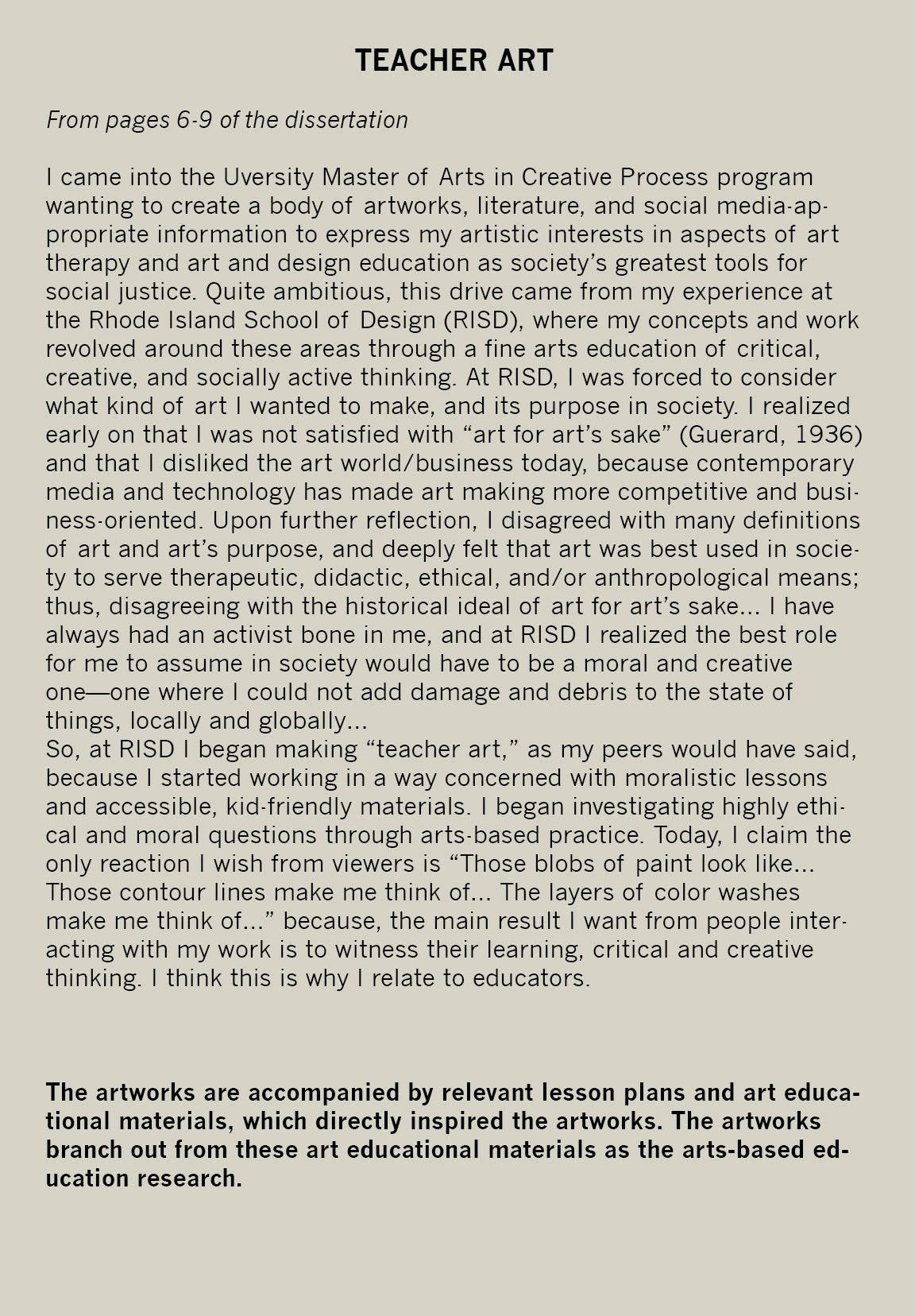
The Backside Series:
Exploring chance in spilling and drying techniques
Exploring chance in spilling and drying techniques
'Honoring chance in the creative process, this series was made under an exercise of intuition. The aim was to create splendid, dried marks through perceptive spilling. In presenting the results of this exercise, the works are offered as examples of a process to the benefit of directly showing viewers what an art-based journey can look like.
‘Hickman adds that culture in art and design education may be taken to mean traditional art and design, “such as drawing from observation and making pots” (“The role of art and design in citizenship education,” 2003). He asserts that while traditional art activities are useful, educators need to locate activities “within in the broader context of education and educating young people as citizens who can make a meaningful contribution to society” (ibid)... Hickman advises educators to recognize the difference of teaching students in art and teaching through art: “the focus being learning about and making art and design as a way of becoming an educated citizen rather than becoming an artist or designer”'... (p.13 of the dissertation).
The educational material on mono printing demonstrates exploration of the backsides of prints—by drawing on the backs of the paper, placed in rolled pigment, to create the drawn image on the front. The backside becomes its own work in the double-faceted process, studying the value in considering all dimensions of an artwork.
Traversing the Texturescape
'“Traversing the Texturescape” is a play on the language around sublime, landscape painting of the nineteenth century. ‘The fascination with the sublime is a worthy pursuit, according to essays in the Whitechapel Documents on Contemporary Art series, because what can be re-presented is commodifiable—it is what cannot be captured that resonates with philosophy and life and is therefore more meaningful’ (p.18 of the dissertation).
The interdisciplinary nature of this installation allows the process of the making of the painting to be captured through video, and through the bottom board—the receptacle and incidental painting. Exercising a thought of sustainability, by catching the run-off paint to create an additional painting, the process behind this piece speaks to ideas of responsibility and intuition in process. ‘Responsibility, knowledge, and autonomy are three aspects necessary in the realization of intuition in the professional practice of an educator... Intuition impacts the educator’s sense of reflexivity between the three aspects and their teaching practice. The reflective sense in the practice makes the educator better in their ability to “wear all hats,” including the moralistic and the socially engaged.’ (p. 14 of the dissertation)
While all works are investigations of mark making, this piece studies how textural surfaces affect surface marks.
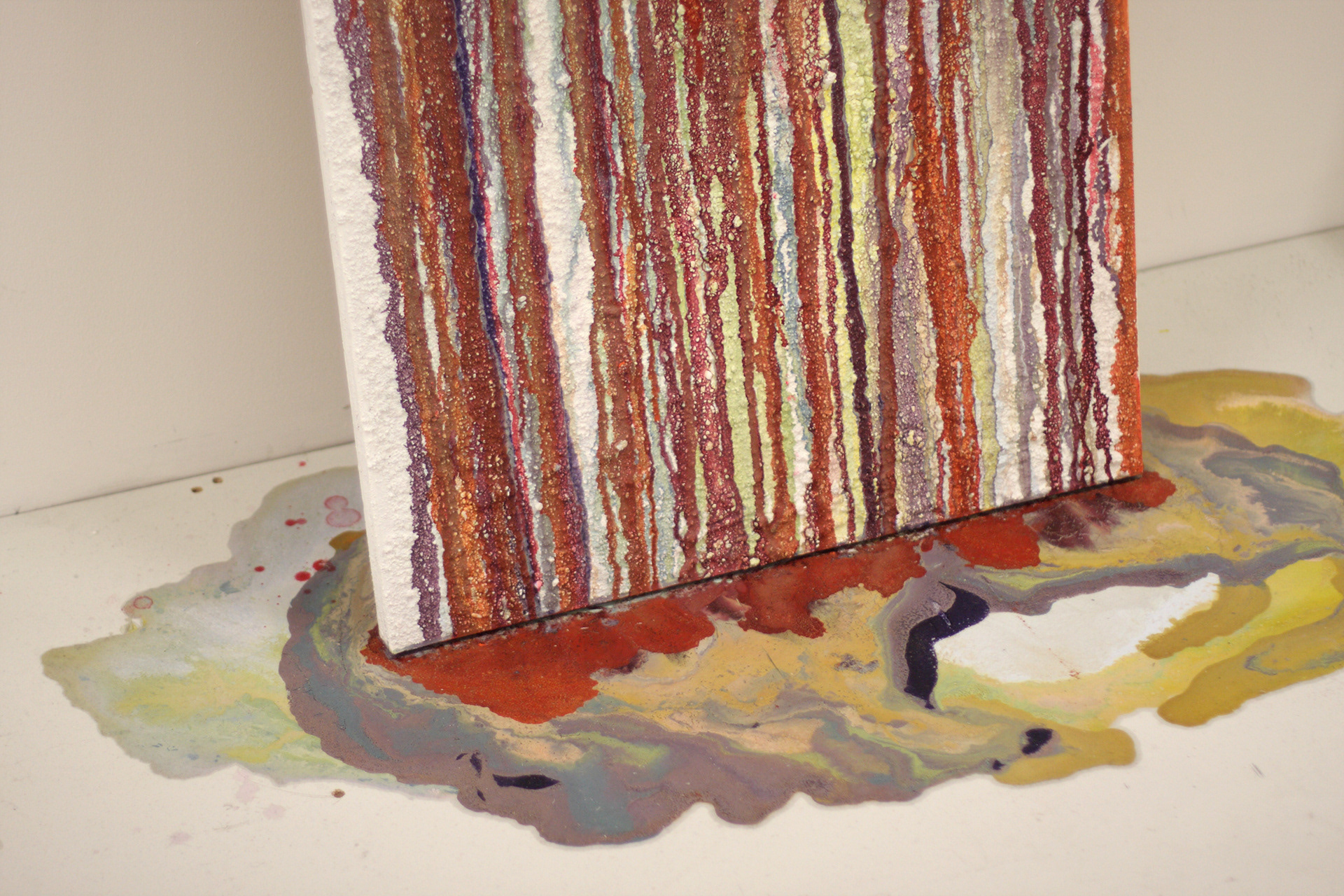
Stills from Traversing the Texturescape
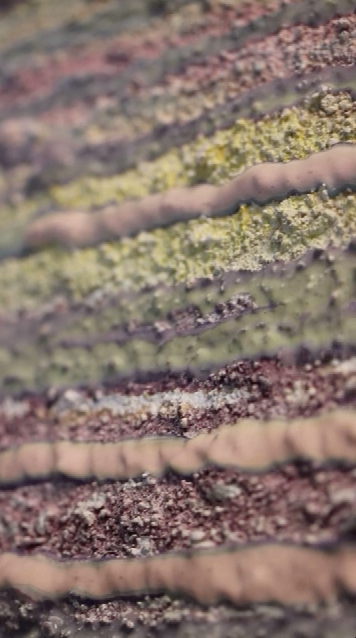


"Infinite Routes," featuring 3 participants
'Moving with direct influence from the abstract rubbing, the task is to find different pathways through the textural surface. 'As Graeme Sullivan discusses in Art Practice as Research: Inquiry in Visual Arts, "...What makes [a] process of meaning making a critical exercise is that there are gaps and ruptures revealed in frameworks of knowledge and these gaps can become the focus for follow-up research (p. 211). As Rachel Jones would say in ON NOT KNOWING: HOW ARTISTS THINK, it's important that these so-called ruptures emerge from a practice to allow for invention, more so, invention that leads to meaning (p.16, 2013). These notions on inquiry, analysis, meaning making, intuition, and the combination of critical and creative thinking can be useful for educators to embody intuitively, as to expand their conceptions of creativity in teaching' (p.18 of the dissertation).
Feel free to participate in this installation by drawing a path across the textured page from any starting point with a provided marker. Most likely, if made independently, no two consecutive paths will be made identically.
Rubbing is the basic technique in this work. The process involves using the resulting abstract textures as beginning stimuli for mark making responses.
Still from Infinite Routes
Mimetic Compositions from the Studio Floor
'In my creative process, I recognize that I am my own teacher. I gain knowledge through my drive to know and to bring original works to fruition. This would agree with the Montessori model, which believes in fostering children's individual inner motivation to inquire into the world, and to power their own learning. Maria Montessori believed that each child has the psychic capacity to form new understanding on their own, given adequate resources and opportunities (The Absorbent Mind, 2012). As French philosopher Jacques Ranciere would put it, "One could learn by oneself and without a master explicator when one wanted to, propelled by one's own desire or by the constraint of the situation" (The Ignorant Schoolmaster, 1999). This is what I feel is at the root of my ability to be my own teacher. In my case, I believe that the "constraint of the situation" is my artistic situation, the studio situation, in which my will to inquire meets the tools and materials I face in the studio' (p.17 of the dissertation).
Translation is the tool for literacy in "Mimetic Compositions From the Studio Floor." Working from floor textures provides many opportunities for abstract qualities, like unpredictable pattern, texture, color, and layers. The paintings/rubbings in the piece honor floor markings as valid visual data, of sorts, opening another pathway for inspiration in the constraint of the studio situation.
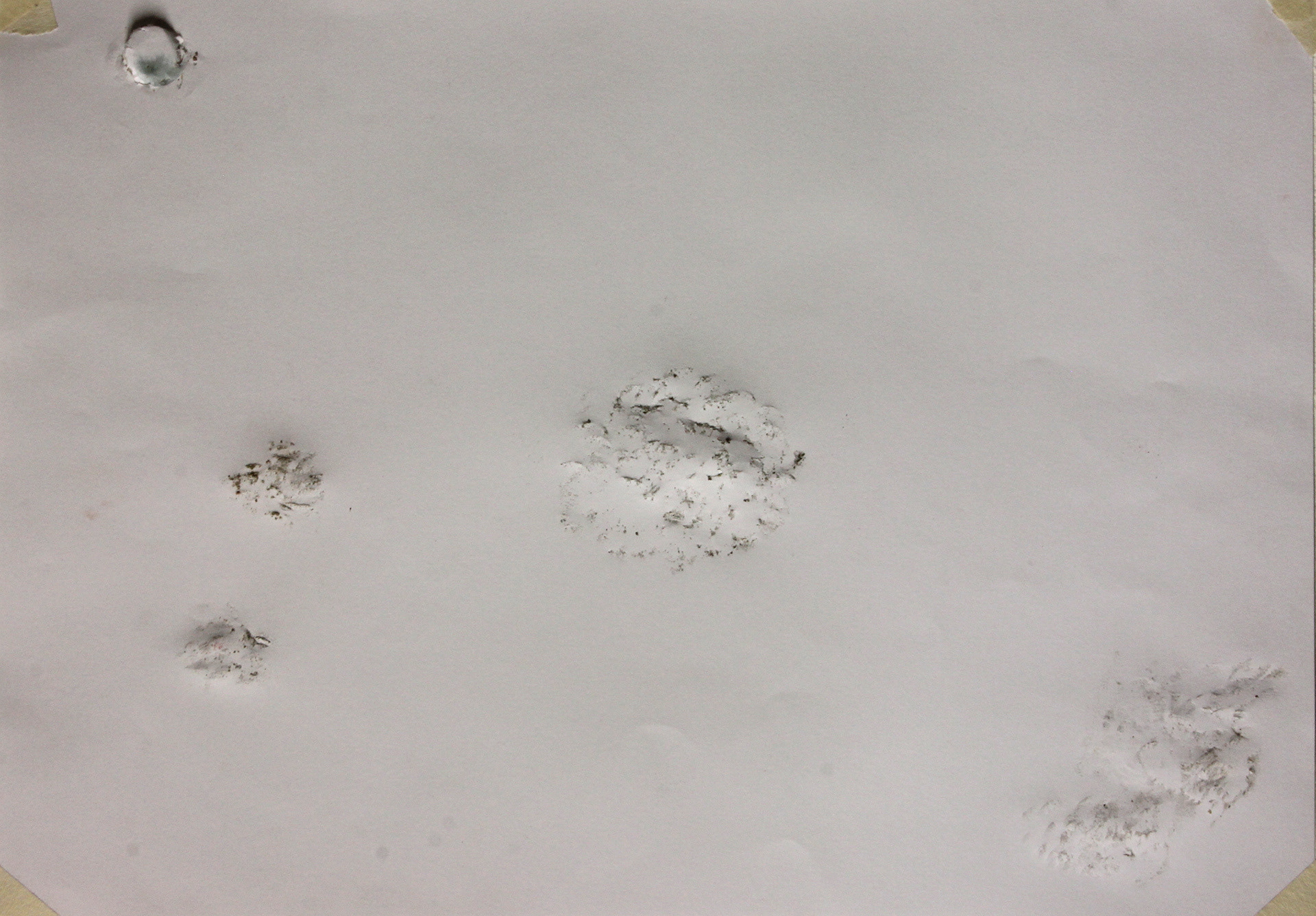
Details from Mimetic Compositions from the Studio Floor
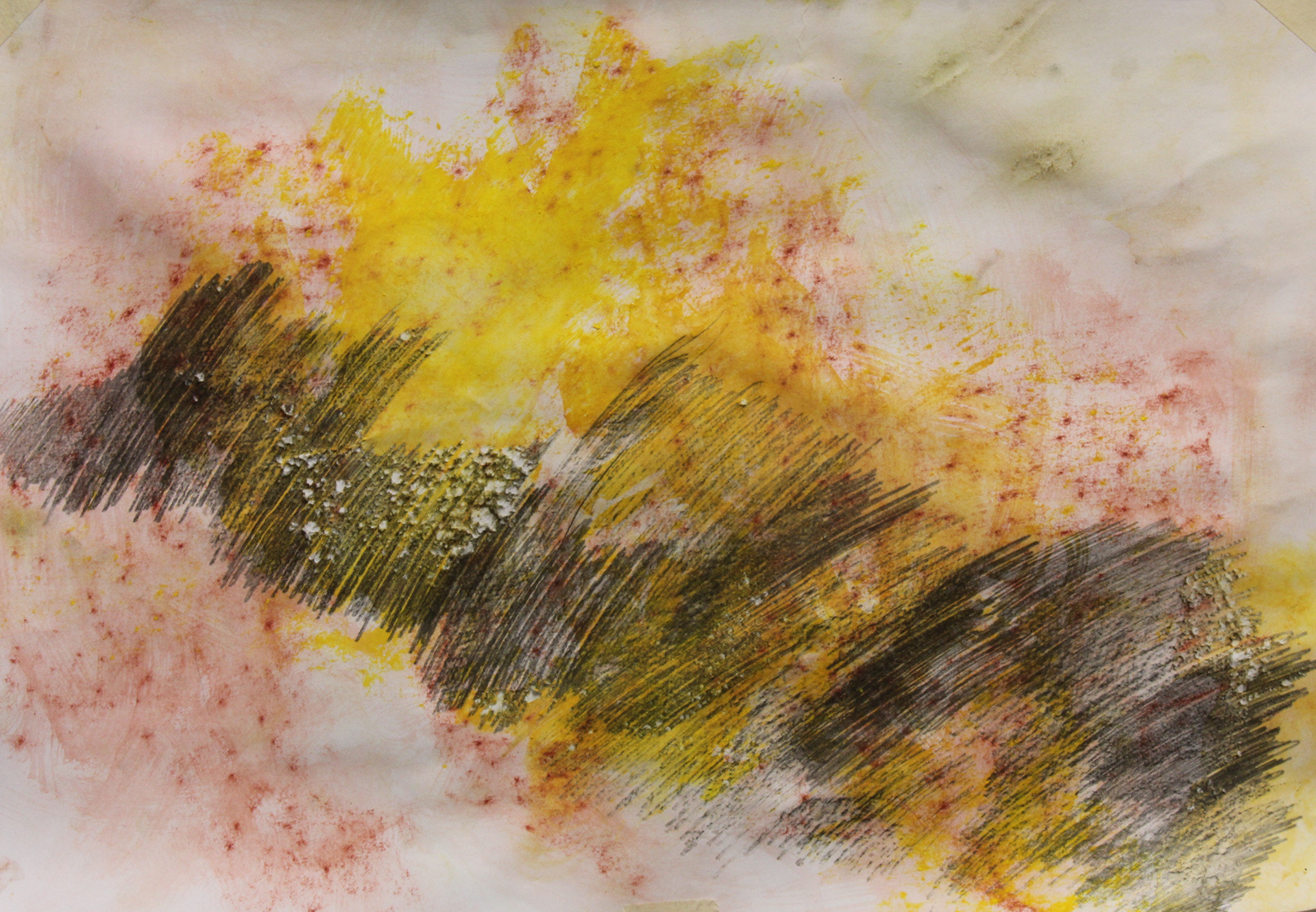

The other side of the corridor
Making Two Pieces Simultaneously at the Spill Station, Demo Video and Installation, with pieces made by participant visitors of the exhibition opening
Inspired by the sensory stations of Montessori schools, "Making Two Pieces Simultaneously at the Spill Station" riffs of the idea of making-stations with painting exploration that is influenced by the direct making environment. Like "Looking through acetate printing plate to imitate texture as abstraction," this piece initially uses a clear working surface as an opportunity to peer past the usual working level to observe visual details beyond--on the floor, for example. Working from observational impetus, the spill station can be used to practice moving paint whilst responding to environmental stimuli. The glass table catches spills and creates an incidental painting artifact.
'Csikszentmihalyi would discuss the misconception of perceiving creativity as an intellectual phenomenon that happens inside a person's head rather as an interaction between "a person's thoughts and a sociocultural context" (Csikszentmihalyi, 2013). Favoring the sociocultural situation, educators could boost students' awareness for all social, political, economical, environmental, local and global issues by considering firstly themselves that creativity is a phenomenon that spurs from these contexts. As learned through interviewing the educators on the Sparks of Creativity program, misconceptions of art and its purpose often get in the way of educators' understandings of art or what it means to be creative' (p. 16 of the dissertation).
Detail from Making Two Pieces Simultaneously at the Spill Station
Looking through acetate printing plate to imitate texture as abstraction
'In the creative process, decision-making is essential, and every artistic move made is a decision. As mentioned in Art & fear, and expressed similarly by many fine artists, from a blank canvas only comes an infinite number of decisions; and with each decision, the path of options becomes narrower and narrower (Bayles & Orland, 2001)... As Eisner listed in What the Arts Teach and How it Shows, his first point is "1. The arts teach us to make good judgements about qualitative relationships. Unlike much of the curriculum in which correct answers and the rules prevail, in the arts, it is a judgement rather than rules that prevail" (p. 70-92, 2002). The decision-making that occurs in art making is analogous to making qualitative judgments in life, relating to the moralistic lessons that grow from engaging in art making' (p. 15 of the dissertation).
As the title suggests, this piece was made while looking through a clear acetate printing plate. The imitated textures come from seen scratches in the worktable's surface. Looking at the scratches solely as abstract marks, the process involved intuitively and rhythmically selecting scratches to copy onto the acetate surface. Using this process without much critical thinking, creative thinking brought the banal surface scratches to a form of abstractions to be seen artistically.
This piece relies on reading between layers in its creation, like the educational material covers.
How We Learn to Read
Like how we actually learn to read text, repetition and layers of information are involved in the process of interpreting and comprehending information. The piece “How We Learn to Read” relies on layers of text and stamped repeats to build up a painting through an intuitive and technical process. Learning to read text relates to how we learn to read visuals—in this case, a series.
‘Inherently in dialogue with the theories of making through visual arts praxis, I found myself increasingly interested in how the process of making a painting, per se, is philosophically similar to that of learning. What my practice shows me these days is that process is more important than product, and that the cyclical nature of exploring problems and answering them independently vitalizes this inquisitive life. Through this, I came to identify with two contexts. The first being living inquiry, which is an important constituent of the second: “a/r/tography.” Living inquiry is the holistic study of life, art, research and teaching. The authors of a/r/tography... explain living inquiry as ‘an embodied encounter constituted through visual and textual understandings and experiences rather than mere visual and textual representations’ (Being with a/r/tography, Springgay). They mention “its rigor comes from its continuous reflective and reflexive stance to engagement, analysis and learning”’ (p.18 from the dissertation).
Poster for the exhibition